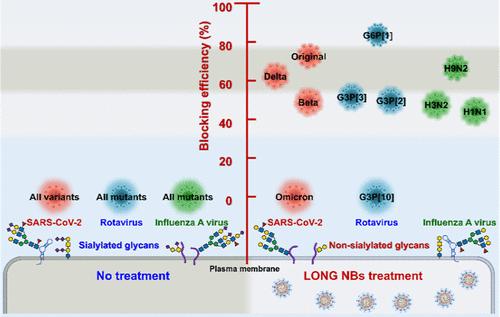Our official English website, www.x-mol.net, welcomes your
feedback! (Note: you will need to create a separate account there.)
Local and Noninvasive Glyco-Virus Checkpoint Nanoblockades Restrict Sialylation for Prolonged Broad-Spectrum Epidemic Virus Therapy
ACS Nano ( IF 15.8 ) Pub Date : 2024-11-13 , DOI: 10.1021/acsnano.4c12434 Xiang Zhang, Pengfei Hao, Juan Mo, Peng-Yu Wang, Guoqing Wang, Letian Li, Xiu-Jing Zheng, Xia Yuan, Wenlong Yao, Ningyi Jin, Chang Li, Xin-Shan Ye
ACS Nano ( IF 15.8 ) Pub Date : 2024-11-13 , DOI: 10.1021/acsnano.4c12434 Xiang Zhang, Pengfei Hao, Juan Mo, Peng-Yu Wang, Guoqing Wang, Letian Li, Xiu-Jing Zheng, Xia Yuan, Wenlong Yao, Ningyi Jin, Chang Li, Xin-Shan Ye

|
The coronavirus disease 2019 (COVID-19) pandemic has driven major advances in virus research. The role of glycans in viral infection has been revealed, with research demonstrating that terminal sialic acids are key receptors during viral attachment and infection into host cells. However, there is an urgent demand for universal tools to study the mechanism of sialic acids in viral infections, as well as to develop therapeutic agents against epidemic viruses through the downregulation of terminal sialic acid residues on glycans acting as a glyco-virus checkpoint to accelerate virus clearance. In this study, we developed a robust sialic acids blockade tool termed local and noninvasive glyco-virus checkpoint nanoblockades (LONG NBs), which blocked cell surface sialic acids by endogenously and continuously inhibiting the de novo sialic acids biosynthesis pathway. Furthermore, LONG NBs could accurately characterize the sialic acid-dependent profiles of multiple virus variants and protected the host against partial SARS-CoV-2, rotavirus, and influenza A virus infections after local and noninvasive administration. Our results suggest that LONG NBs represent a promising tool to facilitate in-depth research on the mechanism of viral infection, and serve as a broad-spectrum protectant against existing and emerging viral variants via glyco-virus checkpoint blockade.
中文翻译:

局部和无创糖病毒检查点纳米阻断剂限制唾液酸化,用于延长广谱流行性病毒治疗
2019 冠状病毒病 (COVID-19) 大流行推动了病毒研究的重大进展。聚糖在病毒感染中的作用已经揭示,研究表明,末端唾液酸是病毒附着和感染宿主细胞过程中的关键受体。然而,迫切需要通用工具来研究唾液酸在病毒感染中的机制,以及通过下调聚糖上末端唾液酸残基作为糖病毒检查点来开发针对流行病毒的治疗剂,以加速病毒清除。在这项研究中,我们开发了一种强大的唾液酸阻断工具,称为局部和无创糖病毒检查点纳米阻断 (LONG NBs),它通过内源性和持续抑制从头唾液酸生物合成途径来阻断细胞表面唾液酸。此外,LONG NBs 可以准确表征多种病毒变体的唾液酸依赖性特征,并在局部和无创给药后保护宿主免受部分 SARS-CoV-2、轮状病毒和甲型流感病毒感染。我们的结果表明,LONG NBs 代表了一种很有前途的工具,可以促进对病毒感染机制的深入研究,并通过糖病毒检查点阻断作为针对现有和新出现的病毒变体的广谱保护剂。
更新日期:2024-11-14
中文翻译:

局部和无创糖病毒检查点纳米阻断剂限制唾液酸化,用于延长广谱流行性病毒治疗
2019 冠状病毒病 (COVID-19) 大流行推动了病毒研究的重大进展。聚糖在病毒感染中的作用已经揭示,研究表明,末端唾液酸是病毒附着和感染宿主细胞过程中的关键受体。然而,迫切需要通用工具来研究唾液酸在病毒感染中的机制,以及通过下调聚糖上末端唾液酸残基作为糖病毒检查点来开发针对流行病毒的治疗剂,以加速病毒清除。在这项研究中,我们开发了一种强大的唾液酸阻断工具,称为局部和无创糖病毒检查点纳米阻断 (LONG NBs),它通过内源性和持续抑制从头唾液酸生物合成途径来阻断细胞表面唾液酸。此外,LONG NBs 可以准确表征多种病毒变体的唾液酸依赖性特征,并在局部和无创给药后保护宿主免受部分 SARS-CoV-2、轮状病毒和甲型流感病毒感染。我们的结果表明,LONG NBs 代表了一种很有前途的工具,可以促进对病毒感染机制的深入研究,并通过糖病毒检查点阻断作为针对现有和新出现的病毒变体的广谱保护剂。


















































 京公网安备 11010802027423号
京公网安备 11010802027423号